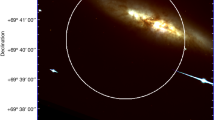Abstract
WHETHER or not neutron-star magnetic fields decay is a matter of current debate. The recent observation1,2 of cyclotron lines from γ-ray-burst sources, thought to be relatively old neutron stars, indicates that they are strongly magnetized and therefore that their fields have not decayed. One interpretation of the correlation observed3 between the strength of the magnetic field and the mass accreted by the neutron star is that mass accretion may itself lead to the decay of the magnetic field. Adopting the hypothesis of accretion-induced field decay, we calculate here the consequent evolution of a neutron star's spin and magnetic field. The results are consistent with observations of binary and millisecond radio pulsars. Thermomagnetic effects4 could provide a possible physical mechanism for such accretion-induced field decay.
This is a preview of subscription content, access via your institution
Access options
Subscribe to this journal
Receive 51 print issues and online access
$199.00 per year
only $3.90 per issue
Buy this article
- Purchase on Springer Link
- Instant access to full article PDF
Prices may be subject to local taxes which are calculated during checkout
Similar content being viewed by others
References
Murakami, T. et al. Nature 335, 234–235 (1988).
Fenimore, E. E. et al. Astrophys. J. 335, L71–L74 (1988).
Taam, R. E. & van den Heuvel, E. P. J. Astrophys. J. 305, 235–245 (1986).
Blondin, J. M. & Freese, K. Nature 323, 786–788 (1986).
Lyne, A. G., Manchester, R. N. & Taylor, J. H. Mon. Not. R. astr. Soc. 213, 613–639 (1985).
Stollman, G. M. Astr. Astrophys 178, 143–152 (1987).
Kulkarni, S. R. Astrophys. J. 306, L85–L89 (1986).
Candy, B. N. & Blair, D. G. Astrophys. J. 307, 535–539 (1986).
Cheng, A. F. Astrophys. J. 337, 803–813 (1989).
Kundt, W. Comments Astrophys. 12, 113–121 (1988).
Ostriker, J. P. & Gunn, J. E. Astrophys. J. 157, 1395–1417 (1969).
Sang, Y. & Chanmugan, G. Astrophys. J. 323, L61–L64 (1987).
Kulkarni, S. R. in Physics of Neutron Stars and Black Holes (ed. Tanaka, Y.) 37–53 (Universal Academy, 1988).
Van den Heuvel, E. P. J. in The Origin and Evolution Neutron Stars (eds Helfand, D. J. & Huang, J-H.) 393–406 (Reidel, Dordrecht, 1987).
Nomoto, K. in The Origin and Evolution Neutron Stars (eds Helfand, D. J. & Huang, J-H.) 282–303 (Reidel, Dordrecht, 1987).
Michel, F. C. Nature 329, 310–312 (1987).
Chanmugan, G. & Brecher, K. Nature 329, 696–698 (1987).
Grindlay, J. E. & Bailyn, C. D. Nature 336, 48–50 (1988).
Brecher, K. & Chanmugan, G. Nature 338, 712 (1989).
Van den Heuvel, E. P. J., van Paradijs, J. A. & Taam, R. E. Nature 322, 153–155 (1986).
Alpar, M. A., Cheng, A. F., Ruderman, M. A. & Shaham, J. Nature 300, 728–730 (1982).
Michel, F. C. Astrophys. J. 290, 721–727 (1985).
Liang, E. Comments Astrophys. 12, 35–49 (1987).
Van Paradijs, J. A. Mon. Not. R. astr. Soc. 238, 45–48 (1989).
Hartmann, D., Epstein, R. I. & Woosley, S. E. Astrophys. J. (in the press).
Wang, J. C. L. et al. Phys. Rev. Lett. (submitted).
Bussard, R. W. & Lamb, F. K. in Gamma-Ray Transients and Related Astrophysical Phenomena (eds Lingenfeiter, R. E., Hudson, H. S. & Worrall, D. M.) 189–200 (American Institute of Physics, 1982).
Ghosh, P. & Lamb, F. K. Astrophys. J. 234, 296–316 (1979).
Alpar, M. A. & Shaham, J. Nature 316, 239–241 (1985).
Lewin, W. H. G., van Paradijs, J. & van der Klis, M. Space Sci. Rev. 46, 273–377 (1988).
Author information
Authors and Affiliations
Rights and permissions
About this article
Cite this article
Shibazaki, N., Murakami, T., Shaham, J. et al. Does mass accretion lead to field decay in neutron stars?. Nature 342, 656–658 (1989). https://doi.org/10.1038/342656a0
Received:
Accepted:
Issue Date:
DOI: https://doi.org/10.1038/342656a0
This article is cited by
-
Exploring the accretion-induced evolution of the spin period and magnetic field strength of Be/X-ray Pulsars
Astrophysics and Space Science (2020)
-
Evolution implications of neutron star magnetic fields: inferred from pulsars and cyclotron lines of HMXBs
Astrophysics and Space Science (2019)
-
Quark novae: An alternative channel for the formation of isolated millisecond pulsars
Journal of Astrophysics and Astronomy (2019)
-
The spin period formation of millisecond pulsar by the torques of accretion and gravitational wave emission
Astrophysics and Space Science (2016)
-
Binary pulsars in magnetic field versus spin period diagram
Astrophysics and Space Science (2013)
Comments
By submitting a comment you agree to abide by our Terms and Community Guidelines. If you find something abusive or that does not comply with our terms or guidelines please flag it as inappropriate.



